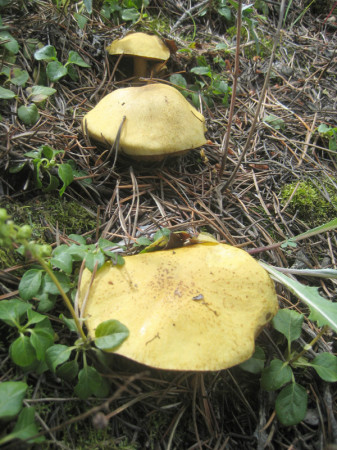
For years I steered clear of the edible mushroom Suillus tomentosus—not because it was difficult to identify, but because it wasn’t supposed to be very good.
“Suillus tomentosus has a reputation for being a second-class edible and is best when very young,” Vera Stucky Evenson writes of the blue-staining, yellow-brown mushroom with fibrillose cap and cinnamon brown spongy pore mass in her book, Mushrooms of Colorado and the Southern Rocky Mountains (1997).
But the thing is, the forest has been covered with these yellow Suillus for the past couple weeks where I live at 10,000 feet in the Colorado Rockies, and throughout the region. My good friend Butter at Hunger and Thirst told me some folks call certain Suillus (I found reference to Suillus americanus) “chicken fat” mushrooms because of their color and texture—and I agree that S. tomentosus also looks like lumps of chicken fat on the forest floor.
“And those darn Suillus everywhere!” Valerie commented at the Wild Food Girl Facebook page. She hunts yellow-gold chanterelles, and the Suillus have been doing everything in their power this year to stand up and scream “look at me, look at me” while pretending to be chanterelles from a distance.
But one day, while stepping over perhaps my 100th Suillus tomentosus to get to other mushrooms, it occurred to me I might be looking a gift horse in the mouth—that I might be passing judgment on the horse based on his teeth, though I knew not the quality of that horse, and above and beyond that, he was a gift.
Here God had been tossing me all these Suillus, and I couldn’t see them for the trees.
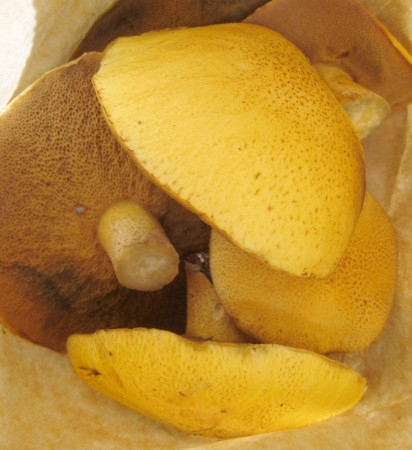
The chicken fat color is a good first indicator that you have a Suillus tomentosus or similar-looking Suillus. After that you have to tickle under the mushroom’s skirt, if you will. Get your finger under the cap and move it back and forth to determine whether you are dealing with a gilled mushroom (a “gilly monster,” as I’ve taken to calling them) or a spongy one, which is what we’re looking for here. That way, you don’t have to knock the mushroom over or pick it if you don’t have to. The yellow cap of S. tomentosus is “fibrillose.” That is, fibril-bearing, where a fibril is “an aggregation of hyphae forming a threadlike filament,” per Evenson. When you cut or bruise Suillus tomentosus, he starts to stain blue. Pretty cool, that.
In any case, there are other Suillus with a spongy pore layer under the cap that are edible, including Suillus lakei (there is a veil; I’ve not yet found one), Suillus granulatus (yellow, sticky and shiny cap with a smooth margin; I’ve found but not eaten these, also due to prejudice and the fact that I haven’t found any yet this season), and Suillus brevipes, my good friend the short-stemmed slippery jack.
In David Arora’s “eminently quotable but not notable for being totable” 959-page tome, Mushrooms Demystified (1986), he lists 52 different species of Suillus. Among them, he writes that “none of the slippery jacks is known to be poisonous, but a few have caused ‘allergic’ reactions,” and that, like other boletes, Suillus can be found in older mushroom books under Boletus. He also levels the accusation that the entire genus is “insipid and slimy when cooked,” and tells us we might as well take advantage of their wetness by using them as an escargot substitute. “You can boil them, flavor them with herbs, stuff them into empty snail shells, and call it ‘Parsley, Sage, Rosemary, and Slime,” he writes. Tee hee. If anybody tries this (wink), please by all means send a picture!
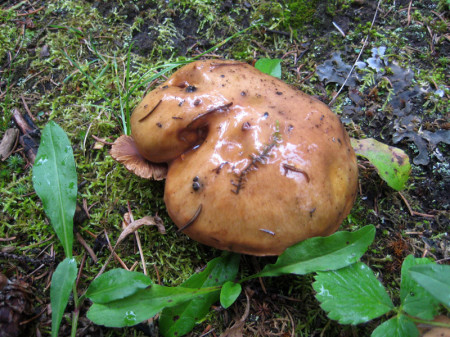
Short-stemmed Slippery Cousin
In retrospect it’s interesting that I’d not eaten the yellow S. tomentosus before this year, as I’ve been eating his cousin, Suillus brevipes, for a couple years now. And short-stemmed slippery jacks also have a reputation for being an inferior edible.
My friend Maria at GreenGabbro.net calls them “mushrooms of failure” because it means you haven’t gotten anything better that day.
Suillus brevipes, like Suillus tomentosus, has a spongy pore-mass layer on the underside of the cap. The cap surface, when young and fresh, is brown, shiny and gooey. If it’s been dry out, and/or the mushroom is older, the cap dries with pine needles and other debris from the forest floor stuck to it. The pores are pale yellow and the stems white in fresh, good specimens. The pores become “dingy olivaceous at maturity,” Evenson writes.
To eat Suillus brevipes, you have to peel the slimy or not-so-slimy glutinous brown skin off the cap. Then sauté those guys (it is commonly accepted that wild mushrooms should be cooked before eating) and give it a go. No matter what people say, Gregg knows how to make short-stemmed slippery jacks real good. I think he dry-sautés them first, then adds butter and sautés until golden brown.
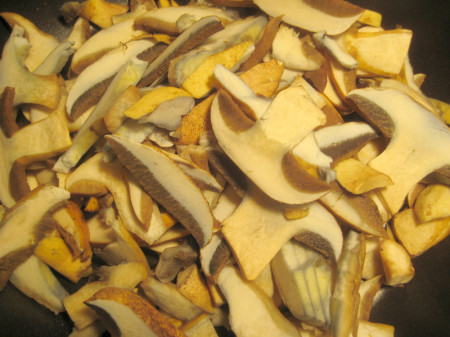
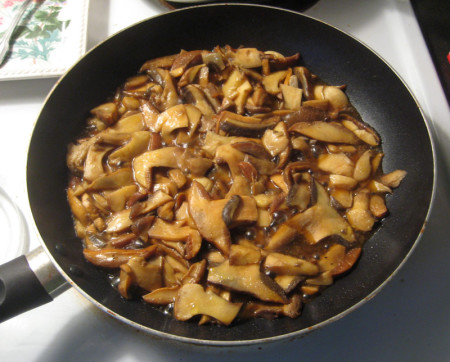
I did, however, have less success drying these mushrooms, grinding and reconstituting them to use in soups or sauces. The soups and sauces got gooey and viscous—slippery, if you will—and not so good that way, although maybe they’d be better reconstituted and not ground up.
Suillus tomentosus
But back to those plentiful Suillus tomentosus. We gathered a batch of them, finally, while on a long hike above our home, on a new mystery trail through dark, shady forest we found up on the mountain. I went for the young, fresh specimens, and quickly filled a pail.
Later, after the mandatory first 12-hour trial on our bodies to observe our reactions to eating a small amount of the cooked mushroom, I sautéed a batch. They exuded much brown juice, but I kept cooking them down until the juice disappeared, and then used them successfully in a stir fry, with the mushrooms taking up perhaps ¼ of the stir fry ingredients.
Similarly, Nathan from Frisco reports on S. tomentosus: “I cooked a few the other day that I had sliced then dried; when I reconstituted them in warm water I got the same effect with that water instantly darkening. But I discarded the water and they went great with the tomatoes, basil and chicken I cooked with them.”
Okay so that’s good news. And, I used S. tomentosus as a “workhorse” along with Colorado spruce-forest hawks wings (Sarcodon imbricatus) in a creamy mushroom soup. (The recipe for that is in the September edition of the Wild Edible Notebook). They worked fine; no slime—though I’m not yet sure if that’s because it’s a different Suillus, or because I used them fresh. The soup was awesome, though Sarcodon’s strong flavor has much to do with that.
Later when I had the opportunity, I gathered another full batch of S. tomentosus and sautéed them down to freeze for a mushroom soup come winter. Hopefully they’ll work better than the dried ones, adding needed texture in combination with dried, flavorful mushrooms like hawks wings or porcini.
Fried Mushroom Sandwich
At the recent Eagle Mushroom festival, Larry Evans of Fungal Jungal seconded my ID on Suillus tomentosus. He commented that S. tomentosus has value as an edible, but that most people cook it wrong, because it sucks up butter and oil like a sponge. Larry said to dip the Suilllus in an egg batter and—it was either breadcrumbs or flour—and pan-fry them.
To try it, I cut the stems off some fresh, firm specimens so the caps could lie flat. These I dipped into egg and flour —the cap flesh along with attached sponge-pore layer—and pan-fried for like 20 minutes, pressing them down with my spatula and flipping occasionally, until the big one stopped whistling.
Yes that’s right—whistling. The big Suillus cap made noise for 20 minutes straight. It whistled and whistled and whistled. I made an amateur video if you’re interested. If you don’t want to watch the whole thing, scroll to the middle or end; the whistling gets more ridiculous:
httpvh://youtu.be/qwz6i59qycg
But anyway, I cooked the Suillus tomentosus caps until they were golden brown and soft and slightly gooey throughout the mushroom, reduced in thickness from like 1½ inches to ½ inch or less. Then I flipped them onto some toasted bread with mayo and previously sautéed farm-fresh peppers and onions.
The sandwiches were great! We’ve had them twice now. But the second time, the Suillus didn’t whistle.

CAUTION 8.26.14: Some mushroom experts, including Michael Kuo in 100 Edible Mushrooms (2007), warn against consuming boletes with a yellow pore surface that bruise blue, especially those with red to reddish-brown caps, as a general practice. Toxic mushrooms that fit this description include Boletus fraternus, he writes, though poisonings from Boletus bicolor and a few other species have been documented.

We also found plenty of these by peaks 3 and 4 above miners creek rd earlier this week, and we brought two home to test. My wife sauteed them without much oil and we had as a side with steak and potatoes. I didn’t like the taste, but perhaps we’ll try with these other methods of cooking.
Did you make the second batch with mushrooms that had been in the fridge for a few days? I wonder if drying them for that long would drive out just enough moisture to keep them from whistling?
Actually B, I think the second batch was fresher. But they were smaller. I’ll try to pay attention to that point on future fried Suillus experiments. Cheers:)
My hero Jacques Pepin made a Buche de Noel (a Yule log) which he decorated with mgiunere mushrooms, first time I ever saw them. Given your love of the forest, that would be an awesome dessert to try. And if Jacques Pepin made it, it is not very complicated.I watched an episode of Top Chef Masters where another one of my chef heroes, Hubert Keller, had to make a dessert for Girl Scouts. He won by making mgiunere swans. What girl would not fall for that?! This one sure did!
I think I have a batch of Suillus lakei on my property. Have you tried cooking them? Thanks for the article. I’m in Washington State just under Mt. Rainier.
I have not cooked and eaten Suillus lakei specifically, just S. brevipes and S. tomentosus. I bet you are getting a bunch of mushrooms where you live right now!
I have found a nearby area with a bunch of Suillus granulatus and I’m gonna try cooking them myself. If you still haven’t tried that species, I’ll let you know how it turns out.
Yes, I slice them up, fry them in a bit of water and pinch of salt, then add a bit of sliced onion and drop some eggs and sliced fresh red pepper in it and stir fry. Wow this makes a good breakfast.
I have cooked many of the Suillusover the years some are very good and some are mediocre…. dried and reconstituted I find them to be terrific
I’m noticing one thing in these comments and this article ….you must be all that viscous cap use latex gloves because it will stain your fingers brown
Your reconstituted liquid will not be slimy
The most common allergic reaction to the slimy caps is an allergic reaction similar to that of poison ivy…. I personally get that reaction! my fingers swell up if I happen to touch my eyelid it swells up and itches and anything else I touch on my body will have the same reaction …it can even affect your Gastro intestinal tract… both beginning and ending!!!. It happened the first time I peeled 100 or so!
I got some of them today for the second time I think. I dry them at 65C for about 6-9 hours depending on how thin you sliced them. When crispy as chips I put them in jars. Then when cooking, crisp of that chips in the oil, cook, soup, meat, whatever. Pure umami, Cheers!